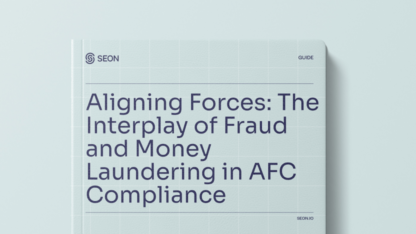Just as certain industries need to monitor customers for persons on PEP, crime, and sanctions lists, businesses operating within OFAC (US), EU, or UK jurisdiction need to make sure they do not deal with companies owned by persons who are sanctioned or otherwise blocked.
Regulating bodies are well aware that structured ownerships of corporate entities can be complex – sometimes intentionally so. For various reasons, the majority owner of a company might be obfuscated behind other companies or representatives.
For cases like these, the 50 percent rule was created – also known as “Entities Owned by Blocked Persons”.
What Is the 50 Percent Rule?
According to US, EU, and UK legislation, if a sanctioned entity or entities constitute 50% of a company’s ownership, that company is also sanctioned. When a company passes this 50% threshold, it is considered blocked from carrying out business within those jurisdictions.
This blocking effectively goes both ways, prohibiting unblocked individuals or companies from doing business with one that is blocked under the rule.
The 50 percent rule was first penned into reality by US regulators in 2008, addressing the relationship between blocked persons and beneficial ownership.
The most recent version of this rule came into law in 2014, expanding the scope to include cases where multiple sanctioned entities aggregate to 50% of overall ownership, though each respective entity may be under the 50% threshold.
Who Is a Blocked Person?
In the course of enforcing the 50 percent rule, OFAC has taken strides to use explicit language, the better to police the space that is dominated by gray areas.
In addition to a blocked person whose name appears on a sanctions list, blacklist or other watchlist, there are additional definitions for those considered blocked without having their name listed specifically:
- a person whose name appears on the Specially Designated Nationals (SDN) or Blocked Persons lists published and updated by OFAC
- a person, entity, organization, country or regime that is a target of sanctions by US economic regulators, currently with special designations for Russian oligarchs and associated parties
- any persons acting as an agent to any of the above are considered, broadly, to be sanctioned by association with the sanctioned person
What Does Sanctioned by Association Mean?
When a company’s ownership by a blocked person crosses the 50% threshold and it becomes blocked itself, the company in its entirety can be referred to as “sanctioned by association”.
This is distinct from being a blocked entity insofar as the entity which is sanctioned by association is inclusive of both the blocked person, as well as the rest of the company that is not owned by the blocked person.
Narrative Sanctions & Relatives
In pursuit of absolute security from violating sanctions, OFAC regulations wander into the dark jungle of narrative sanctions. These entities whose names do not explicitly appear on any recognized sanctions list. Sometimes, narrative sanctions are called implicit sanctions. Rather, these people are also considered blocked persons through their relationship to other blocked entities.
The narrative in question can be as simple as being a family member or a specific employee of an explicitly sanctioned company.
Some narratives, however, are much more complex, and problematically challenge what is possible when it comes to carrying out enhanced due diligence. These are things like terrorist groups using videos and social media to promote their ideology. Persons appearing in such media may not have their names known to be included on a sanction list but are included in the narrative sanction of that obviously blocked terrorist group.
Sectoral Sanctions and Russia
Cases in which particular industries in particular countries become sanctioned are called sectoral sanctions. As with the current sectoral sanctions on Russia, these are often imposed in cases of war or the instigation of international violence.
When those sanctions were first announced in 2018, it was noted that Russia’s government “operates for the disproportionate benefit of oligarchs and government elites” as an addendum to the list of the following blocked people:
- designated Russian oligarchs
- designated oligarch-owned companies
- designated Russian state-owned firms
- designated Russian government officials
When Does the 50 Percent Rule Apply?
The 50 percent rule applies whenever a sanctioned or blacklisted entity or person owns more than 50% of another entity. In this case, the latter receives the same sanctions or limitations and it can’t do business in the affected territory – neither can entities in that territory do business with the sanctioned entity.
In order to address the potential loopholes in the rule resulting from complicated ownership structures, the legislature goes into detail about which cases specifically qualify as meeting the required 50%. The most recent adjustments to the legal language are intended to address ownerships where multiple blocked persons have – in all likelihood – intentionally structured their investment to individually represent less than 50%, in order to fly under the OFAC radar.
The applications of the 50 percent rule as they currently stand are meant to cast a broad net over risk associated with breaking sanctions. This includes language to fold in both direct and indirect ownership. As these terms represent a potential legal murkiness, the US Treasury details examples where the rule applies, to help define the outer limits of the rule’s jurisdiction.
Examples of the 50 Percent Rule
The following are OFAC’s examples of 50 percent rule qualification, which can include historical violations. They are inclusive of instances of “indirect” ownership:
| indirect ownership | If a blocked person owns at least 50% of Company X, Company X is considered blocked. If Company X then owns 50% of Company Y, Company Y is also considered blocked, despite the fact that the blocked person does not directly own it. |
| aggregate ownership | A blocked person owns 50% of Company A and 50% of Company B. Company A and Company B each own 25% of Company C. Company C is considered blocked, as the aggregate ownership of the blocked person constitutes 50% of Company C. |
| joint ownership | If Blocked Person A and Blocked Person B both own 25% of Company Z, Company Z is considered blocked. |
| combined ownership | Blocked person owns 50% of Company Q and 10% of Company P. Company Q also owns 40% of Company P. In this case, Company P is considered blocked, because the blocked person is considered to indirectly own 40% of Company P, in addition to directly owning 10%, totaling to 50%. |
SDN-Controlled Entities and Significant SDN Ownership
Outside of these explicit examples, there are instances of rulebreaking that are not considered within the 50% rule but are subject to similar regulation.
One such scenario is where a company is not blocked but is being represented by a blocked person who has controlling interests in the entity, and that person is not the legal owner. For example, they can be the CEO. Entering into contracts with that person is considered a violation, even when the company itself is not subject to sanctions or other blacklisting.
OFAC also recommends caution when US entities approach business deals with entities that do not quite meet this threshold, as with companies where a significant interest is held by a blocked person.
This intends to safeguard against becoming culpable should the scope of the rule change, or in cases where due diligence seems to have been neglected.
Exxon Mobil, for example, was fined $2 million for dealing with Rosneft, a Russian oil company with a large interest held by SDN-listed Igor Sechin, according to a report from the BBC. Though Sechin did not hold direct or indirect ownership of the company, regulators still felt that contracting with Sechin was problematic.
Who Does the 50 Percent Rule Apply To?
The OFAC 50 percent rule must be observed by all US persons who would do business of any kind with a foreign entity, though there are specific industries that regulators keep under close watch such as those that are more likely to be used for money laundering and terrorism financing according to AML and CFT legislation.
Until the Patriot act of 2001, financial institutions were the primary focus of OFAC regulations in terms of industries that needed to be the most sanction-compliant. Since then, the 50 percent rule also specifies certain verticals beyond money services that are considered high-risk. These industries also get higher scrutiny for violations, so should take particular care:
- casinos
- importing/exporting brokers
- insurance
- dealers in jewelry, precious gems, or art
- real estate agencies, particularly at the high end
- nonprofit organizations and charities
- travel agencies
Notably, OFAC has also regularly imposed heavy fines on rulebreakers in other verticals, like energy, tech, and electronic payment providers.
Understand what sanctions screening is, why it matters, and how to do it right. Read the guide to stay compliant and reduce risk.
Sanctions Screening Guide
What Are the Consequences of Breaching OFAC Sanctions?
When a US personage or company violates OFAC sanctions, the exact punishments vary depending on the US entity, scale of the violation, and what industry it occurred in. Regardless of vertical, however, the consequences are dire and include sizeable fines, blacklisting and criminal prosecution.
Apart from the potential for reputational damage for doing business with a sanctioned entity, OFAC also details a list of actionable punishments. The potential consequences include:
- being designated a sanctioned entity, effectively becoming unable to interact with US businesses
- large fines that can reach up to almost $300,000 per violating transaction
- criminal prosecution with up to 20 years of imprisonment
- assets being frozen or, in the case of certain physical assets, even destroyed
These fines, when levied, tend to be towards the maximal end of the spectrum. In other words, while there are sometimes ways to mitigate punishment, the punitive action is never small.
That being said, OFAC encourages (by way of lower fines) companies that discover, internally, that they have dealt with a blocked person to:
- volunteer the discovered issue willingly
- cooperate during any investigation
- be observant of OFAC recommendations, such as state-of-the-art cybersecurity and compliance programs
- not make any attempts to conceal wrongdoing or show a pattern of such behavior
- be informed of the relevant issues at stake and the situation itself
Are Your AML and KYC Processes OFAC Compliant?
Almost every AML software solution will be checking OFAC’s SDN list with every transaction, but even OFAC knows that this may not be enough to steer clear of violating sanctions. In cases of things like persons who are sanctioned by narrative, cross-checking the SDN list will not be enough to keep your company compliant.
There are plenty of protocols that your fraud prevention software can or should be able to execute to prevent sanctions violations from washing up on the shores of your business.
In particular, SEON’s customer screening software can help you check if any stakeholders in a potential business partnership are sanctioned persons, whether they are on OFAC’s lists, EU blacklists, PEP lists and beyond.
Any watchlist hits can be added to exclusion lists, and then incoming traffic can be compared against entries on that list. SEON can be adjusted to look for specific characteristics that suggest an association with those sanctioned entities, like a similar IP geolocation or device hash. It will also flag software and tools that are frequently used to hide the real location or identity of the person.
In many cases, OFAC violation exposure can be mitigated by simply doing this kind of enhanced due diligence, even if the results are inconclusive. SEON can provide an easily reviewable data trail for your conducted investigations within the user activity log, and data points are easily extractable in a .csv file.
The lawmakers who drew up the existing version of the 50% rule were fully aware that they had handed a tall order to organizations. They knew that as soon as new regulations are imposed on beneficial ownership statutes, SDN-blocked persons immediately change their ownership structures.
They also knew that the people explicitly named on the SDN list are outnumbered by the unnamed, narratively sanctioned persons by up to 20 to 1.
Inside of these realities, the successful execution of an enhanced due diligence scheme leveraging AML screening and anti-fraud technology should be the baseline for covering your legal bases.
FAQs
Any financial transaction involving a US entity of any type is subject to OFAC sanction regulation. This can extend to include a non-US entity that acts as a middleman between a US entity and a potentially SDN-listed individual.
OFAC sanctions exist across three lists:
1. Specially Designated Nationals (SDN)
2. Consolidated Sanctions List
3. Additional OFAC Sanctions List
OFAC sanctions are used to diminish the economic power of malignant groups like terrorists and drug traffickers. OFAC itself was created to replace the FFC, a government body whose purpose was to protect foreign currencies and exchanges from falling into Nazi hands during World War II.
You might also be interested in:
- SEON: Your Complete Guide to PEP Screening
- SEON: Guide to Sanctions Screening: What is It & How to Perform It
- SEON: The Best Sanctions Screening Software and Tools in 2025
Sources








